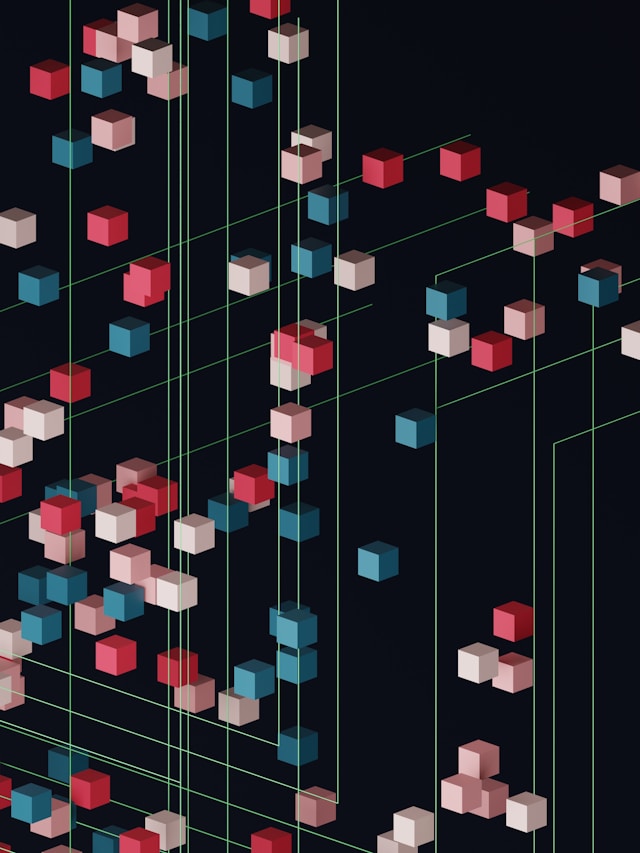
Leveraging blockchain in nuclear security: enhancing transparency and efficiency
The integration of blockchain technology in nuclear security represents a transformative advance, addressing the dual demands of transparency and robust security in the management of nuclear materials. Blockchain technology, known for its decentralized and immutable record-keeping capabilities, offers a revolutionary approach to secure and transparently track nuclear materials from production through to disposal, thereby enhancing compliance with stringent international regulations and improving global security.
Introduction to blockchain technology
Blockchain technology is a digital platform known for its key characteristics of decentralization, immutability, and transparency. It operates as a distributed ledger that records all transactions across a network of computers. Each transaction is recorded in a “block” and linked to previous and subsequent blocks, forming a chronological “chain.” This structure ensures that information cannot be altered once it is entered, thereby providing a secure and tamper-proof system. This technology is widely recognized for its potential to enhance security and efficiency in various sectors, including finance, supply chain management, and now, nuclear security.
Blockchain’s impact on nuclear material tracking

Blockchain technology represents a transformative shift in how nuclear materials are tracked, managed, and audited. It introduces a paradigm where each phase of a nuclear material’s lifecycle—from production to disposal—is documented in an immutable and transparent ledger. This digital innovation ensures that all records are tamper-proof and readily available, which is essential for a material that poses significant security risks.
The process begins at the very inception of nuclear materials. As soon as nuclear material is produced, its details are recorded on a blockchain. This initial record includes the material’s type, quantity, form, activity and any other relevant data defining its characteristics. Each subsequent step—whether the material is moved, utilized in energy production, or transferred between facilities—is logged as a separate transaction on the blockchain. This creates a chronological chain of custody that is both verifiable and irreversible.
The advantage of using blockchain in this context is manifold. For one, it enhances the security of nuclear materials. By creating a permanent record of every transaction that cannot be altered retroactively without detection, blockchain technology significantly lowers the risk of illegal or unauthorized activities. Each entry requires validation by multiple parties before it is added to the ledger, which also disperses the control of the information, reducing the potential for fraud or data manipulation.
Moreover, blockchain’s transparency and real-time data access are invaluable for regulatory bodies and international watchdogs like the International Atomic Energy Agency. These entities require consistent and accurate information to ensure that nuclear materials are not diverted to illicit uses or fall into the wrong hands. Blockchain enables real-time auditing and monitoring, facilitating swift responses to any discrepancies or anomalies in the supply chain. It effectively supports nuclear non-proliferation treaties and domestic regulations by providing a reliable tool for enforcing compliance.
In addition to security and compliance, blockchain technology simplifies the logistical aspects of nuclear material management. The immutable record of transactions allows for more straightforward and quicker verification processes, reducing administrative burdens and enhancing operational efficiencies. This can be particularly beneficial for nuclear waste management, where accurate historical data are crucial for tracking the decay and transformation of materials over time.
Blockchain also introduces the possibility of integrating smart contracts—self-executing contracts with the terms of the agreement directly written into code—into the nuclear material supply chain. These contracts could automate many aspects of nuclear material management, such as triggering alerts if materials are not processed according to schedule or if unauthorized access is detected. This not only enhances operational efficiency but also significantly increases the level of security by reducing human error and the potential for insider threats.
Blockchain applications in grid cybersecurity
As the complexity of cybersecurity threats to energy infrastructures like the national power grids increases, the need for advanced security measures becomes paramount. Blockchain technology is emerging as a key player in enhancing the security, reliability, and resilience of these critical systems. The Pacific Northwest National Laboratory is leading the charge in embedding blockchain to protect the grid against both cyberattacks and physical threats, utilizing its distributed ledger for data integrity and smart contracts for automated system interactions.
PNNL’s use of blockchain helps ensure data integrity and transparency by maintaining a tamper-proof record of all grid operations, which is crucial for auditability and regulatory compliance. The technology’s decentralized nature reduces the risk of single points of failure, which can be exploited during cyberattacks, and supports quicker recovery from operational disruptions.

Blockchain’s application extends to enhancing operational efficiency through automated compliance and operational processes, significantly reducing the potential for human error. Furthermore, the cryptographic security provided by blockchain enhances overall grid cybersecurity, securing data transmitted across the grid and ensuring the integrity of communication among smart meters and IoT devices.
The vulnerabilities of smart grids, particularly in relation to interconnected smart meters and IoT devices, introduce significant security risks. Blockchain technology can mitigate these risks by securing data exchanges and authenticating user identities, thereby protecting the grid infrastructure from potential cyber threats.
Synergy between blockchain and SMRs
The advent of SMRs, such as the MK60 developed by Deep Atomic, marks a significant step forward in nuclear technology, particularly in its application to high-density energy consumers like data centers. SMRs are designed to be compact and scalable, providing a sustainable and efficient solution to meet the robust energy demands of modern digital infrastructures. Their smaller size compared to traditional nuclear reactors allows for easier siting and less complex logistical requirements, while their modularity supports phased construction strategies that can align more closely with actual energy demand growth.
Integrating blockchain technology with SMR operations enhances this next-generation nuclear solution by improving security, transparency, and efficiency at every stage of the nuclear power lifecycle. From tracking the origin and movement of nuclear materials to monitoring the operational status of reactors and managing the disposal of nuclear waste, blockchain provides a robust framework for managing the complex data involved in nuclear energy systems.
Blockchain’s role extends beyond material tracking; it also revolutionizes how energy produced by SMRs is managed and integrated into power grids. This capability is crucial for integrating SMR-produced energy with national grids or local microgrids, facilitating a more reliable and efficient energy distribution system. For example, the energy output from an SMR like the MK60 can be dynamically allocated across a microgrid, responding in real-time to changes in demand without compromising security or efficiency.
Moreover, the application of blockchain in this context supports compliance with international standards and regulatory requirements, providing a verifiable and tamper-proof record of compliance across the reactor’s operation. This not only aids in regulatory reporting and reduces administrative burdens but also enhances public and stakeholder trust in SMR technology as a safe and sustainable energy source.
Blockchain’s distributed ledger technology also allows for the implementation of smart contracts, which can automate many of the operations associated with energy distribution, such as dynamic pricing, fault management, and the activation of backup systems. This automation can help to optimize the operational efficiency of SMRs, reducing the potential for human error and increasing the responsiveness of the system to changes in supply and demand.
Global adoption by tech giants
As the digital economy expands, leading global technology firms such as Microsoft, Google, and Amazon face increasing demands for sustainable and reliable energy sources to power their extensive data centres and cloud services. To address these challenges, these tech giants are progressively turning to nuclear power, specifically leveraging SMRs to ensure a stable and continuous energy supply. SMRs represent a promising advancement in nuclear technology due to their smaller size, reduced waste, and enhanced safety features compared to traditional nuclear reactors.

The integration of blockchain technology with SMR operations marks a significant innovation in this sector. Blockchain plays a critical role in managing and tracking the lifecycle of nuclear energy—from fuel production and energy generation to waste handling and decommissioning. By recording every transaction on a secure and immutable ledger, blockchain technology enhances the security and transparency of nuclear energy management. This capability is crucial for tech companies committed to sustainability and responsible energy use, as it provides verifiable proof of where and how energy is produced and utilized.
For instance, Microsoft has signed agreements to reboot old nuclear facilities and develop new ones, using blockchain to monitor and manage the energy produced. Google has also entered into partnerships to utilize blockchain to track energy usage and production in its data centers powered by newly developed nuclear technologies. Meanwhile, Amazon is exploring similar initiatives, aiming to power upcoming data centers with nuclear energy that is meticulously tracked and managed via blockchain systems.
These initiatives are part of a broader strategy to meet increasingly stringent global carbon reduction targets. The use of SMRs, complemented by blockchain’s oversight, allows these companies not only to enhance their operational efficiencies but also to substantiate their claims of using clean energy. This dual approach not only supports their sustainability goals but also helps maintain reduced carbon footprints, setting a benchmark in the tech industry for energy management.
Moreover, the application of blockchain in nuclear energy management by these tech giants fosters greater regulatory compliance and public trust. By ensuring that energy sourcing and waste management are conducted transparently and securely, blockchain technology mitigates risks associated with nuclear energy, thus enhancing its acceptance and feasibility as a sustainable energy solution.
Blockchain technology’s role in nuclear security and energy management is multifaceted and expanding. By providing an unalterable record of nuclear material movements and energy transactions, blockchain technology not only enhances the security of sensitive materials but also promotes operational transparency. As this technology continues to mature, its integration into nuclear security operations and energy management systems is expected to yield significant benefits, promoting not only safety and compliance but also supporting the global transition towards more sustainable energy solutions. This integration represents a critical step forward in addressing some of the most pressing challenges in global energy management and nuclear nonproliferation.



